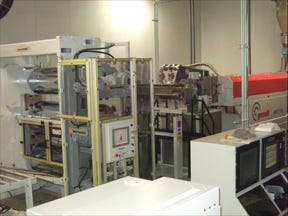A polyethylene terephthalate (PET) sheet system precludes drying and provides throughputs of 2000 lb (900 kg) per hour with lower overhead compared to non-vented extrusion processes.
November 29, 2009
A polyethylene terephthalate (PET) sheet system precludes drying and provides throughputs of 2000 lb (900 kg) per hour with lower overhead compared to non-vented extrusion processes. Utilizing Davis-Standard LLC (D-S; Pawcatuck, CT) engineering and project management, and winding with a Multi Rotation System (MRS) extruder from Gneuss Inc., the collaborative result aims to replace single-screw extruders currently used to process post-consumer or industrial flake PET.
|
In the conventional setup, moisture and volatiles must be removed through drying so that the polymer chain doesn’t break down during the melt phase. In order to be dried, the feedstock must be crystallized to withstand elevated temperatures. Gneuss and D-S point out that crystallizing and then drying PET not only takes time, but requires more energy, equipment, and plant space.
With the new technology, a blender combines post consumer or industrial flake PET with virgin pellets from each component’s blender hopper in one step. Once blended, the resin is vacuum conveyed to the feed throat of the MRS extruder for processing, without having to crystallize or dry the material.
Gneuss says the operations of its MRS extruder are comparable to the vent section of a single- or twin-screw extruder where melt-stream degassing occurs under precise vacuum control. In the case of the MRS, however, the degassing section is much larger, surpassing the surface exchange of a twin screw by 25 times and a single screw by 50 times and making it possible to remove moisture and volatiles in the melt stream more efficiently.
Among the advantages to be gained, the companies say, is that a more moderate vacuum level can be applied, enabling processors to use less-expensive and easier-to-maintain vacuum equipment. In addition, the melt undergoes low shear and thermal stress; strong pressure build-up can eliminate the need for a gear pump; and overall less energy and space are required. FDA approval for processing PET bottle flakes is pending.
In addition to the blender loader hopper and the MRS, the system includes a Gneuss RSFgenius melt-stream filter, an inline viscometer, an online X-ray gauging system, a roll stand with independent roll-speed control, and a turret winder for 48-inch diameter rolls weighing more than 5000 lb (2200 kg). The system utilizes D-S’s EPIC closed loop winder control. The system was engineered so that finished sheet can be fed directly into a thermoformer's shaping trays for use with fresh food items like strawberries and tomatoes. —[email protected]
About the Author(s)
You May Also Like



